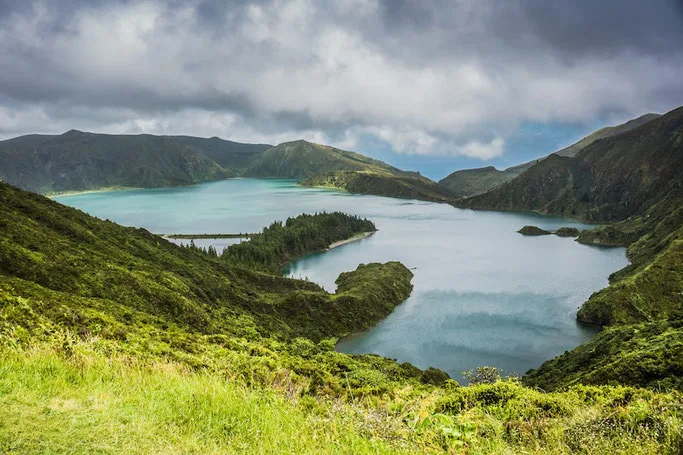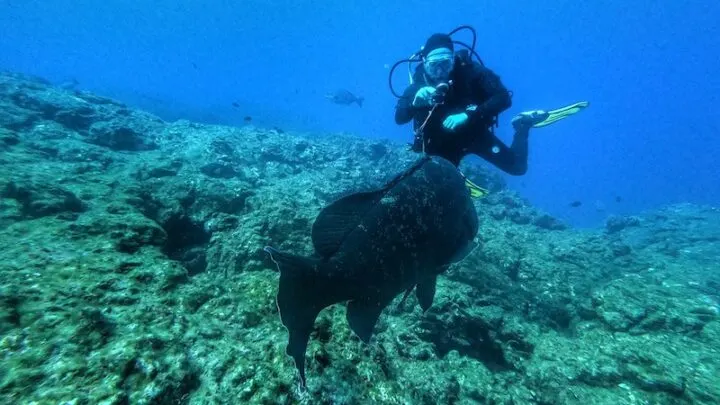For European scuba divers, the idea of diving with phenomenal pelagic species usually brings on thoughts of far flung destinations in Asia or the Caribbean. That is, until they learn about the Azores.
Scuba diving in the Azores offers world-class sightings of some incredible species. Residents include blue sharks, whale sharks, mako sharks, mobula rays and manta rays. The volcanic archipelago is an autonomous Portuguese territory consisting of nine islands. The Azores are situated in the Atlantic Ocean, approximately 1500km west of mainland Portugal. The location and convergence of currents makes this spot a haven for spotting big creatures in the blue.
In order to protect this unique location, many dive operators are conservation-minded and run programmes rooted in ecotourism. For this reason, the Azores were recently named as a Mission Blue Hope Spot. As well as the wonders under the surface, the lush landscapes above the water makes the Azores a great spot for land-based activities such as hiking, cycling and horse riding.
This European hidden gem is a diver’s paradise. Read on to learn everything you need to know about scuba diving in the Azores. We’ll share which sites to dive and which islands to visit, how much it costs to scuba dive in the Azores, and what certification level you need to dive in these stunning islands.
How to get to the Azores
The main international airport is in Ponta Delgada, located on São Miguel island. Most European cities offer flights directly into this airport. North American travellers can also fly to Ponta Delgada via Boston or Toronto. From both mainland Europe and North America, the flight time is around 4-5 hours.
The other eight islands of the archipelago can be accessed by a network of airports with flights managed by local airline SATA Air Azores. Ferries also operate between the islands, although schedules can be more challenging outside of the summer season.
What can I see whilst scuba diving in the Azores?
The Azorean waters are positively teeming with life. From crustaceans to cetaceans, there is something to suit every scuba diver. If you’re hoping for sightings of large creatures, look out for whale sharks, manta rays, mobula/devil rays, blue sharks, and mako sharks. If you’re particularly lucky you may even see Galapagos or smooth hammerhead sharks. Whilst there are both resident and migratory whales which visit the Azores, you’re more likely to see these from the surface than whilst on a dive.
The big guys are often accompanied by schools of fish which can be as impressive as the sharks and rays themselves. Yellowmouth barracuda, amberjacks, guelly jacks (white trevally), Atlantic bonito, wahoo, skipjack tuna and bigeye tuna can appear in numbers up to the thousands, depending on the dive site. Large groupers also often visit divers at a number of popular sites.
If you’re more at home photographing smaller underwater inhabitants the Azores also has plenty of macro life on offer. Although the volcanic underwater landscape doesn’t offer colourful coral, look out for sponges and crusting anemones. The crevices and crannies still house interesting inhabitants. You’ll find moray eels, octopus, nudibranchs, hermit crabs and unicorn shrimp.
Beyond the incredible oceanic fauna, the volcanic structure of the archipelago creates some awe inspiring topography. Expect canyons, caverns and gullies galore as you glide through crystalline visibility of up to 40m (130 feet).
When should I travel to the Azores?

The main scuba diving season in the Azores runs June-September. The calmest and warmest water conditions fall between June and August. During September temperatures begin to drop, but this month can often offer some of the best visibility.
Water temperature varies from 15ºC during the winter to a maximum of 23ºC during the summer months. The air temperature is cold in comparison to mainland Europe due to the mid-Atlantic location. It’s similar to the water temperature, from a minimum of 14ºC (57ºF) in the winter up to 25ºC (77ºF) in the summer.
If you’re heading to Pico or Faial for whale watching, May is the month to try to catch a glimpse of their migration. However, the temperature tends to be around 16ºC (61ºF) and water conditions can be extremely changeable early in the season. It’s advisable to allow a few extra days in case of boat cancellations due to inclement weather.
Which dive sites and islands should I visit in the Azores?
Perhaps the most famous site of the Azores is Princess Alice Bank. The site is around three hours from either Pico or Faial. With depths of 35-40m (115-131 feet) and strong currents this is definitely a site for more advanced divers, but if you have the required certifications it’s not one to be missed.
Large aggregations of up to thirty mobula rays swarm around as you hang on to the line from the boat. Blue sharks are also often sighted at Princess Alice, with a small chance of whale sharks too.
If you’re based in the eastern islands of São Miguel and Santa Maria, the offshore islets of Ilhéus das Formigas can offer a similar experience. This is usually combined with the seamounts of Dollabarat. The sites are located three nautical miles apart, therefore they can be completed in one day.
The marine life sightings will depend on the specific spot visited, but expect devil/mobula rays, and the possibility of Galapagos sharks. If you’re lucky, you may even see smooth hammerheads, and large schools of other pelagic species.
Ambrósio is another site offering similar marine megafauna. This is much closer to land and only 40 minutes away from Santa Maria. It’s a hotspot for manta rays during the summer months, and Santa Maria island is the island most visited by whale sharks.
Shrimp Cave is a 10 minute boat journey from Faial. This offers the opportunity to see large numbers of candy striped unicorn shrimp, accessed through a narrow underwater corridor. For wreck lovers, check out the SS Dori from the south coast of São Miguel.
Are there any liveaboards in the Azores?
Like many archipelagos with incredible scuba diving, a liveaboard trip is a fantastic way to make the most of the Azores. This will allow you to see a large variety of dive sites in a short space of time. It also maximises the opportunities to hit up the offshore sites where the larger marine megafauna like to explore. There are just a few liveaboards in the Azores, including intimate sailing yacht Water and Wind. This boat comes recommended by a number of Girls that Scuba members.
What certification do I need to scuba dive the Azores?
Most scuba diving locations can cater to any level of diver, and the Azores is no exception. If you’re travelling with non-divers, there are opportunities for them to snorkel or take on a try dive experience. However, to make the most of these islands you may want to have a few more dives in your log book.
The offshore dives offering the chance of pelagic encounters are often in the blue. This requires you to have great control over your buoyancy. It’s also important that you’re comfortable in the water for these dives. Being out in the blue with little visual reference can often lead to disorientation.
Similarly, some of these sites can have strong currents which may be challenging for newer divers. For this reason, some operators will put minimum certification level expectations or minimum dive number requirements in place to be able to go on specific trips.
As well as the conditions, consider the water temperature. If you’re used to tropical diving in a rash vest, the additional restrictions of a thicker exposure suit and the weight you’ll need to go along with it may take some getting used to.
With water temperatures rarely exceeding 21ºC (70ºF) most divers will choose to wear a 7mm semi dry suit. You may also want a hood and gloves to stay warm. If these colder conditions are new to you, seek out additional training at the beginning of your trip.
How much does scuba diving in the Azores cost?
The cost of scuba diving in the Azores is comparable to most diving destinations around the world. A single dive averages around €50. Most dive operators will run two tank trips, though, so expect to pay approximately €100 for two dives.
If you’re planning on diving on multiple days, you’ll get better value by purchasing a package of dives. A package of 10 dives can bring the cost as low as €32 per dive.
These prices are for divers who have their own equipment – expect to spend a little extra if you need to rent any gear. Equipment rental is generally charged per day, with a charge of around €20 per day being the norm for full kit hire.
Special dives to the offshore seamounts such as Princess Alice or Formigas and Dollabarat will incur an additional cost. Expect to spend between €250-€350 for these unique trips. Cost will depend on the departure island, number of dives and distance to the offshore site.
Who should I dive with in the Azores?
Dive operators can be found on most of the islands of the Azores. Some of the most highly recommended from members of our Girls that Scuba community include Twin Peaks Diving Centre and CW Azores, both based on Pico island. On São Miguel check out Best Spot Azores, and Mantamaria Dive Center on Santa Maria island.
Espírito Azul, also on São Miguel, is part of our Girls that Scuba Membership Card programme and offers GTS cardholders a 10% discount. Click here to see the full list of dive operators and brands involved, and to learn how much you can save on your scuba shopping!
Are the Azores on your scuba bucket list? Which of the islands have you visited already? Share your trip highlights to our Facebook group, or tag us in your Instagram stories for a chance to be featured – we’re @girlsthatscuba!

